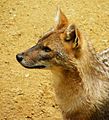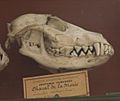Golden Jackal facts for kids
The golden jackal (Canis aureus) is a wild animal that looks a bit like a dog or a small wolf. You can find them in Southeast Europe, Southwest Asia, South Asia, and parts of Southeast Asia. Compared to the smallest gray wolves, golden jackals are smaller. They have shorter legs, a shorter tail, a longer body, and a narrower, more pointed snout.
The color of a golden jackal's fur can change with the seasons. In summer, it might be a pale creamy yellow. In winter, it can turn a darker, brownish-yellow. These animals are doing very well in the wild. They are listed as "Least Concern" by the IUCN Red List. This means there are lots of them, and they live in many places where they can find plenty of food and safe spots to live.
Scientists believe the golden jackal's ancestor was an ancient dog relative called the Arno river dog. This animal lived in Mediterranean Europe about 1.9 million years ago.
Contents
Where Golden Jackals Live and How They Behave
Golden jackals love to live in valleys and near rivers, streams, canals, lakes, and seashores. They are not often found in hills or mountains. Golden jackals are social animals. Their main group is usually a breeding pair (a male and a female) and their young pups.
These animals are very good at adapting to different environments. They can eat many different things, from fruits and insects to small hoofed animals. They might even attack farm animals like chickens or young water buffalo calves.
What Golden Jackals Eat
Golden jackals are both hunters and scavengers. This means they hunt for their own food and also eat animals that are already dead.
In places like Bharatpur, India, more than 60% of their diet includes small animals like rodents and birds, as well as fruits. In the Kanha Tiger Reserve, about 80% of what they eat is rodents, reptiles, and fruit. They also eat a lot of plants. In India, they enjoy fruits from plants like buckthorn, dogbane, Java plum, and the pods of mesquite and the golden rain tree.
Jackals will also scavenge for food left behind by bigger predators. They might eat leftovers from kills made by lions, tigers, leopards, dholes, and gray wolves. In some parts of Bangladesh and India, jackals survive by eating dead animals and garbage. If they find extra food, they will bury it to save it for later.
Golden Jackal Competitors
Golden jackals have other animals that compete with them for food and territory. These include the red fox, the wolf, the jungle cat, and the forest wildcat. In some areas, they also compete with raccoons and steppe wildcats.
The golden jackal is actually spreading beyond its usual homes in Southeast Europe. They are now moving into Central Europe. They often settle in areas where there are not many wolves, which helps them find new places to live.
Images for kids
-
Skull of a European jackal (C. a. moreoticus) at the National Museum of Natural History, France
-
Golden jackal in Kaeng Krachan National Park, Thailand
-
Indian jackal (C. a. indicus) feeding on chital carcass in Pench National Park
-
Syrian jackal (C. a. syriacus) pup at the entrance to its den, Yarkon Park, Israel
-
Tabaqui (left) torments Father Wolf and his family, as illustrated in the 1895 edition of Rudyard Kipling's The Two Jungle Books.
-
Jackals hunted in Vojvodina
-
European jackal undergoing training at Sheremetyevo Airport, Russia
See also
 In Spanish: Chacal común para niños
In Spanish: Chacal común para niños















